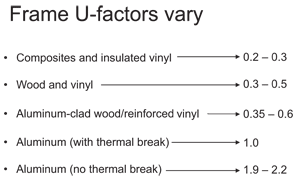Building Green with Windows and Doors
Managed correctly, wood is a renewable resource. Many window manufacturers purchase their lumber from sources that belong to the Sustainable Forestry Initiative (SFI). SFI manages 136 million acres of forestland in North America and has planted five million trees since its inception in 1995. SFI products are now available with a certification label. The other sustainable forestry group is the Forest Stewardship Council (FSC), which is a global sustainable forestry group that manages less than 13 million acres worldwide. FSC wood products qualify for LEED points and maintain a strict chain of custody throughout the harvesting and manufacturing process. FSC also offers a certification trademark to products made from its timber. However, the majority of U.S. forests are owned by private individuals who most commonly own small lots of 1,000 acres or less and do not find it economical to follow FSC practices. Conscientious window manufacturers do their best to check on original lumber sources.
Smaller cut pieces of wood are used as finger joints, edge gluing joints and veneers which results, in both less waste and making a stronger, straighter window.
*Vinyl (PVC) is a versatile material with good insulation value and is available in a wide range of shapes and styles. Vinyl frames do not require painting and offer good moisture resistance. Vinyl and vinyl clad windows and doors also offer low conductivity. But vinyl offers less structural rigidity or strength by itself and expands and contracts at a rate eight times that of pultruded fiberglass. This leaves vinyl products susceptible to seal failures, stress cracks, fading, chalking and cracking.
Vinyl windows often become brittle with age and may not last as long as a well-maintained wood window. The pigment in darker vinyl breaks down after exposure to UV light, which causes fading. Due to the likely fading problem with darker hues of vinyl, manufacturers often opt to work with lighter shades.
Vinyl window products tend to lack the durability to contribute to a sustainable life cycle building initiative.
*Pultruded fiberglass frames offer superior energy efficiency because fiberglass incorporates insulating air pockets. Pultrusion is a fabrication process that produces lineal profiles. Coated fibers are (pulled) through a die where, under pressure and heat, the resins are cured. The physical properties of pultruded fiberglass do not change through the full temperature cycle up to 350 F. (PVC resins become unstable at 155 F.)
Pultruded fiberglass will not warp under heat or rot, is resistant to chemicals and moisture and can be painted-with low VOC-emission paint if required. It also has excellent structural strength, rigidity, a low rate of expansion and contraction, low thermal conductivity which ensures a window and door will remain square, maintains its seals and performs as tested for years to come. Pultruded fiberglass also resists scratches, dings, corrosion, fading and scratching for a superior low maintenance experience.
|
It is ideal for large expanses of glass and is also virtually maintenance-free. However, the rigid make-up of fiberglass may limit design flexibility because curved surfaces are more difficult to produce.
Silica sand is the primary component in the manufacturing of pultruded fiberglass and is an abundant and sustainable resource.










